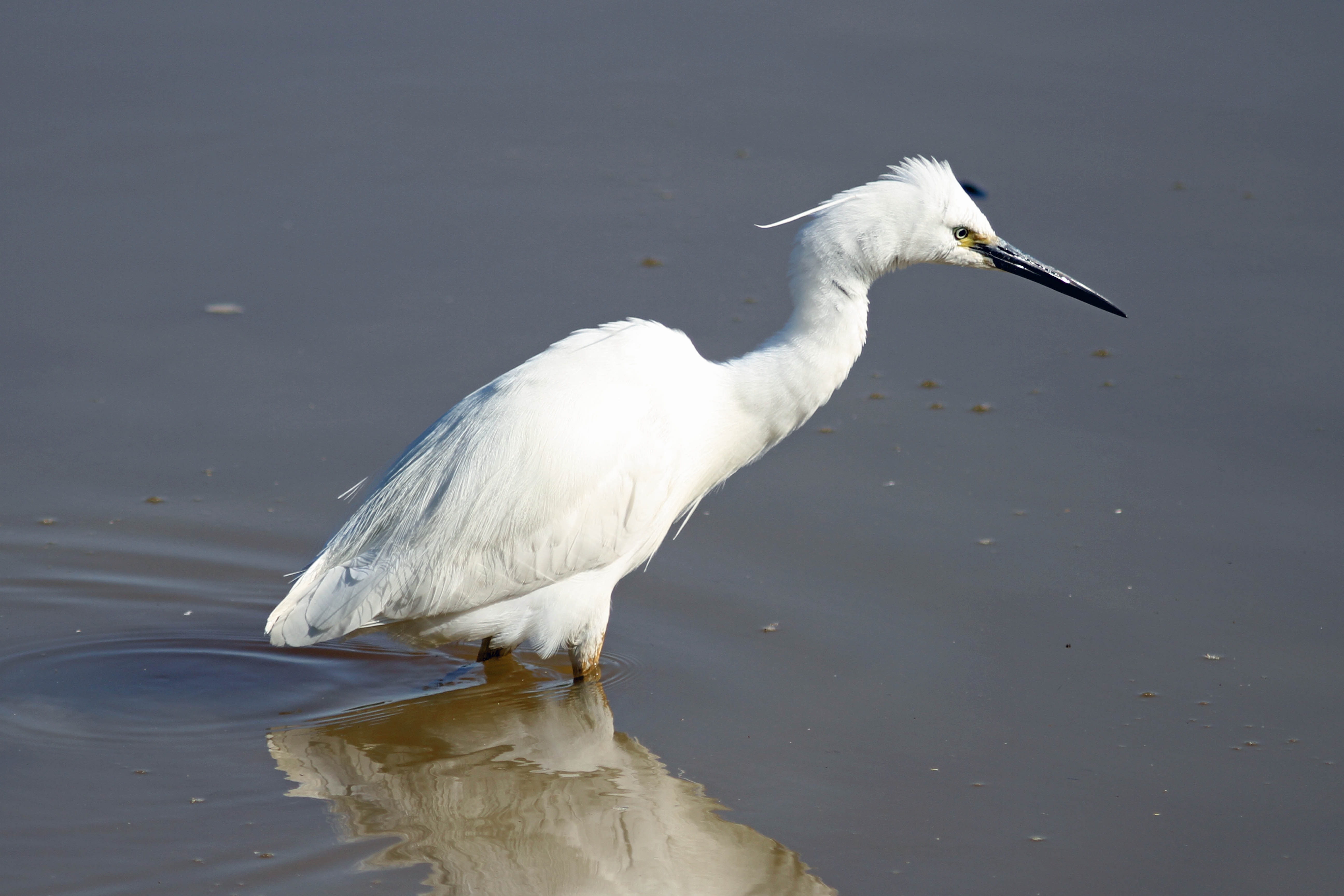| Citation |
BirdLife International 2016. Egretta garzetta. The IUCN Red List of Threatened Species 2016: e.T62774969A86473701. http://dx.doi.org/10.2305/IUCN.UK.2016-3.RLTS.T62774969A86473701.en. Downloaded on 20 September 2019. |
Description |
RANGE DESCRIPTION
This species has a large range, with an estimated global Extent of Occurrence of 1,000,000-10,000,000 km2. It has a large global population estimated to be 660,000-3,150,000 individuals (Wetlands International 2015).
DESCRIPTION
The global population is estimated at 660,000-3,150,000 individuals. Totals for E. g. garzetta and E. g. dimorpha from Wetlands International (2015) added together. The European population is estimated at 66,700-84,800 pairs, which equates to 133,000-170,000 mature individuals (BirdLife International 2015).
Trend Justification: The overall population trend is increasing, although some populations may be stable and others have unknown trends (Wetlands International 2006). The European breeding population trend is estimated to be decreasing (BirdLife International 2015) or stable (EBCC 2015) in the short-term.
HABITAT AND ECOLOGY
Behaviour All populations of this species undergo post-breeding dispersive movements (del Hoyo et al. 1992). Populations breeding in the Palearctic are highly migratory (Hancock and Kushlan 1984) whereas others are only sedentary (such as E. g. dimorpha on Madagascar), nomadic (del Hoyo et al. 1992) or partially migratory (Hancock and Kushlan 1984). The timing of breeding varies geographically (del Hoyo et al. 1992) although, in general, European and north Asian populations breed in spring and summer (March to July) and the breeding of tropical populations coincides with periods of high rainfall (Kushlan and Hancock 2005). The species usually nests in colonies sometimes of thousands of pairs and often with other species (del Hoyo et al. 1992). Some populations also breed solitarily or in small single-species groups of under 100 pairs (del Hoyo et al. 1992). When not breeding the species commonly feeds solitarily or in loose flocks during the day (del Hoyo et al. 1992). Habitat It inhabits fresh, brackish or saline wetlands (del Hoyo et al. 1992) and shows a preference for shallow waters (10-15 cm deep) in open, unvegetated sites where water levels and dissolved oxygen levels fluctuate daily, tidally or seasonally, and where fish are concentrated in pools or at the waters surface (Kushlan and Hancock 2005). Habitats frequented include the margins of shallow lakes, rivers, streams and pools, open swamps and marshes, flooded meadows, rafts of floating water hyacinth Eichornia spp. on African lakes (Kushlan and Hancock 2005), flood-plains (del Hoyo et al. 1992), lagoons, irrigation canals, aquaculture ponds (Kushlan and Hancock 2005), saltpans (del Hoyo et al. 1992) and rice fields (which are especially important in areas with few remaining natural wetland habitats) (Hancock and Kushlan 1984, Kushlan and Hancock 2005). The species also occupies dry fields, inland savannas and cattle pastures (del Hoyo et al. 1992) and some populations are almost entirely coastal, inhabiting rocky or sandy shores, reefs, estuaries, mudflats, saltmarshes, mangroves and tidal creeks (del Hoyo et al. 1992). Diet It is a highly opportunistic feeder (Kushlan and Hancock 2005), taking mainly small fish under 20 g in weight and less than 10 cm long (del Hoyo et al. 1992) (averaging 4 cm) (Kushlan and Hancock 2005), aquatic and terrestrial insects (e.g. beetles, dragonfly larvae, mole crickets and crickets) (Kushlan and Hancock 2005) and crustaceans (del Hoyo et al. 1992) (e.g. Palaemonetes spp., amphipods, phylopods, crabs and exotic species of crayfish) (Kushlan and Hancock 2005) as well as amphibians, molluscs (del Hoyo et al. 1992) (snails and bivalves) (Kushlan and Hancock 2005), spiders, worms, reptiles and small birds (del Hoyo et al. 1992). Breeding site The species may nest on the ground in protected sites (Kushlan and Hancock 2005) or up to 20 m high on rocks, in reedbeds, bushes, trees or mangroves (del Hoyo et al. 1992). It usually nests in single- or mixed-species colonies where nests may be placed 1-4 m apart (sometimes less than 1 m apart) (Kushlan and Hancock 2005). It may feed up to 7-13 km away from breeding colonies during the breeding season (del Hoyo et al. 1992). Management information An artificial island nesting site created in the Camargue, France succeeded in attracting nesting pairs to the area (Hafner 2000). A study in north-west Italy suggests that existing nesting sites should be protected and that breeding habitats should be actively managed in order to maintain suitable habitat characteristics (Fasola and Alieri 1992). The creation of a network of new nesting sites spaced at 4-10 km in relation to available foraging habitats in zones currently without suitable nesting sites is also recommended (Fasola and Alieri 1992).
THREATS
The species is threatened by wetland degradation and loss through drainage for agriculture (e.g. rice-farming and fishing), changes in current management practices (e.g. of rice-farming) and contamination from agricultural and industrial operations (Kushlan and Hancock 2005). The species is also susceptible to avian influenza so may be threatened by future outbreaks of the virus (Ellis et al. 2004, Melville and Shortridge 2006), and it previously suffered from hunting for the plume trade (although this is no longer a threat) (del Hoyo et al. 1992, Kushlan and Hancock 2005). Nesting colonies of E. g. dimorpha are depredated by villagers in Madagascar (Langrand 1990).
CONSERVATION ACTIONS
Conservation Actions Underway
The species is listed on Annex I of the EU Birds Directive and Annex II of the Bern Convention.
Conservation Actions Proposed
The following information refers to the speciess European range only: An artificial island nesting site created in the Camargue, France succeeded in attracting nesting pairs to the area (Hafner 2000). A study in north-west Italy suggests that existing nesting sites should be protected and that breeding habitats should be actively managed in order to maintain suitable habitat characteristics (Fasola and Alieri 1992). The creation of a network of new nesting sites spaced at 4–10 km in relation to available foraging habitats in zones currently without suitable nesting sites is also recommended (Fasola and Alieri 1992). Freshwater habitats need to be sustainably managed. Establish non-intrusion zones around colonies. |

